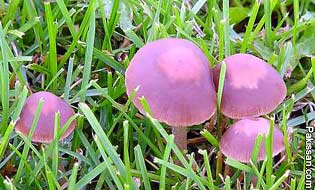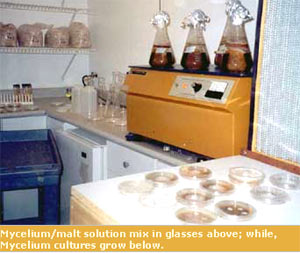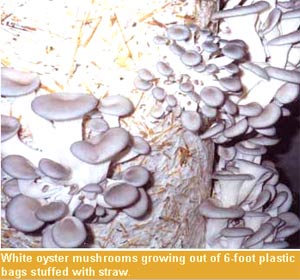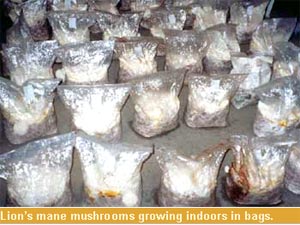|
Farming the Fungi Kingdom - Organically
By Jason Witmer
Mushrooms should be a critical part of agriculture, they’re
the recyclers,” says Thomas. “We’re growing all kinds of
fibers and we’re throwing them out and dumping them in
landfills. I can grow oyster mushrooms on shredded soy-ink
newspaper.”
 The
Wiandts produce a variety of mushrooms in just a few small
buildings nestled among an old-growth forest. They have made
this pursuit economically viable enough to leave their former
careers, and they contend that in an ideal society,
mushrooms—grown on entirely waste products—could provide an
extremely efficient protein source. The
Wiandts produce a variety of mushrooms in just a few small
buildings nestled among an old-growth forest. They have made
this pursuit economically viable enough to leave their former
careers, and they contend that in an ideal society,
mushrooms—grown on entirely waste products—could provide an
extremely efficient protein source.
Four years ago, the two were sitting unhappily behind
desks—Thomas was an engineer, and Wendy was a medical
technologist. Looking for another kind of life, the two saw
potential in their mushroom-collecting hobby. “We were both
professionals with desk jobs and wanted to get the heck away
from that,” Thomas says. “I grew up on a farm and I always
wanted to get back to a small farm type of living.”
“We did a lot of research and looked at several different
possibilities,” he recalls. “Mushrooms are a good fit.
Everything always breaks and I’m always fixing everything—so
that suited me. And this is probably the most laboratory
intensive kind of farming there is.” That suited Wendy, who
had spent time working in a medical laboratory.
Though they still hunt and market wild mushrooms from their
46-acre, organically-certified woods, they now specialize in
homegrown oyster, shiitake, and lion’s mane mushrooms. These
go to farmers' markets, retail outlets, and restaurants
A different kind of farming
The process of growing mushrooms begins with mycelia, which
the Wiandts isolate from the wild or, more often, purchase in
a t est
tube from a laboratory. As beer brewers do with yeast, the
Wiandts drop bits of mycelia into a malt sugar solution. They
leave them there for a couple weeks until the concoction looks
like tapioca pudding. est
tube from a laboratory. As beer brewers do with yeast, the
Wiandts drop bits of mycelia into a malt sugar solution. They
leave them there for a couple weeks until the concoction looks
like tapioca pudding.
Once the mycelia are mature, they put small samples of the
liquid broth into bags of sterilized rye grain, seal the bags
and transfer them to a room held at 75 degrees. After about
two weeks, when the mycelia have spawned, the Wiandts
distributed the rye through bags of packed straw or sawdust.
After another two weeks, the mushrooms begin fruiting out of
holes poked in the bags. The mushrooms fruit up to five times
and Thomas and Wendy harvest them twice a day.
The most difficult thing about the process is keeping out
contaminants, such as molds. If contaminants enter the bags,
the mushrooms will not fruit and weeks of labor are wasted.
Each transfer must be done in a sterile environment—by using
laminar flow hoods and sterilizers, and an electronic
filtration system for removing spores from the air. “A lot of
the work is more difficult than the work Wendy used to do in
the hospital laboratory,” Thomas says.
The Wiandts are experimenting with growing hen-of-the-woods
and shiitake mushrooms outdoors on rotting logs, which seems
to be as efficient as growing them indoors. The process is the
same except that they inoculate dowel plugs with mycelium,
instead of rye. They insert these into the logs and seal them
with beeswax.
|
Mushrooms are so absorbent – they’re sponges. How can
you put pesticides on those? That’s just not acceptable. |
Pest control is the biggest factor
separating Killbuck Valley mushrooms from those that are
conventionally produced. Conventional mushroom producers use
large amounts of pesticides because mushrooms attract many
pests, including birds and insects. But the Wiandts are
strongly against using chemicals. “Mushrooms are so
absorbent—they’re sponges,” says Thomas. “How can you put
pesticides on something like that? It's just not acceptable.”
Without chemicals, the Wiandts must control pests manually,
and this is much more labor intensive. They use a rotation
schedule in rooms, separating new bags from older ones, so
that pests don’t spread. They also use screening and
filtration to keep insects out of rooms and sticky strips to
catch those that do get in. If a column gets too contaminated
they throw it out prematurely instead of treating it with
chemicals.
Sizing up the mushroom market
Unfortunately, because mushrooms are such an unusual product
already, the Wiandts don’t receive a higher price for being
organic. There are two outlets that buy from them because they
don’t use chemicals, but they don’t pay any more. “There’s a
lot of added expense in being organic,” Thomas says. “It’s
just something that we happen to believe in.”
 Nonetheless,
the Wiandts are doing well economically. This is in part
because they are the only small-time grower in the region.
Since mushrooms don’t transport well, Killbuck Valley's
products look much better than those from large commercial
producers. Nonetheless,
the Wiandts are doing well economically. This is in part
because they are the only small-time grower in the region.
Since mushrooms don’t transport well, Killbuck Valley's
products look much better than those from large commercial
producers.
The Wiandts get their highest price at farmers' markets, which
make up more than half of their sales in the summer. They
receive $7.50 a pound for oyster mushrooms and $9.50 a pound
for shiitake. To reduce waste, Wendy has begun pickling the
mushrooms they don’t sell. They now have a licensed cannery
and sell the pickled mushrooms at market.
The Wiandts feel that contributing to farmers' markets is
important. “Organic or not, there are no commercial producers
at the farmers markets,” Thomas says. “They’re all small
farmers, good people, very ethical people. If you go there
you’re making your society a better place—automatically.”
The markets also give the Wiandts a chance to promote and
educate people about their product. “We can sell tons more
products at the farmers' market, at a higher price, because
we’re there educating people and talking to people and
developing relationships,” Thomas explains. “And putting out
samples so folks can try them." Offering samples is critical,
the Wiandts say, because people are are naturally reluctant to
pay for a premium product they may have never tasted before.
The Wiandts seek to dispel the myth that mushrooms don’t
contribute to a healthy diet. Mushrooms are actually high in
carbohydrates, contain up to 30 percent protein—including
important amino acids—and are high in mineral content. There
are also studies being conducted on the immuno-stimulus
properties of mushrooms such as oyster and shiitake.
“Everybody thinks mushrooms have no nutritional value because
the USDA doesn’t have them on their charts,” Thomas says.
“They need their own category,” Wendy suggests. “The fungus
category.”
After having promoted their products at farmers' markets for
years, the Wiandts have now had more success with retail
stores and restaurants because customers are beginning to
recognize their products. While they only receive about 70
percent of the market price from restaurants and retailers,
the loss in profit is about the same as the extra expense they
put into selling retail. Selling to these venues also
increases their efficiency at market because they can sell
more when they go only once every two weeks.
"Organic or not, there are no commercial producers at the
farmers markets. They’re all small farmers, good people, very
ethical people. If you go to those you’re making your society
a better place – automatically."
The Wiandts feel that producing year-round is a key to their
successful restaurant trade, accounting for over 50 percent of
their sales during the winter. Though they make no profit
during these months, due to increased labor and decreased
sales, they maintain customers.
“If we were just producing in the summer the customers would
go elsewhere and we wouldn’t have the good relations with
restaurants,” says Wendy. “That’s a huge issue with the chefs.
They want somebody they can rely on. If they have an item on
the menu, they want to make sure that they can leave it on the
menu.”
“Chefs aren’t looking for a bargain,” Thomas agrees. “Chefs
are looking for good reliable products, and good, long-term
relationships. They’re willing to pay a little extra if they
know it's going to be good stuff all the time and they don’t
need to worry about it.”
Tending a business, and attending to community
The Wiandts pay close attention to the economic side of their
business so that they won’t
 have
to return to their old desk jobs. They also stay active in the
agricultural community. They have recently hosted wild
mushroom hikes for chefs and public events for the Ohio
Agricultural Research and Development Center. have
to return to their old desk jobs. They also stay active in the
agricultural community. They have recently hosted wild
mushroom hikes for chefs and public events for the Ohio
Agricultural Research and Development Center.
Thomas is also a member of the Ohio Farm Bureau – a lonely
place for someone with his values. “It's extremely unusual for
an organic farmer, because the Farm Bureau has an anti-organic
agenda,” he says. “But I figure you can’t have any say if
you’re not there. The more organic farmers abandon it, the
worse it’s going to get. So I try to stay active and put my
two bits in.”
"Chefs aren’t looking for a bargain. Chefs are looking for
good reliable products, good relationships, and long term
relationships. And they’re willing to pay a little extra... to
make sure that it’s going to be good stuff all the time."
The Wiandts believe that mushrooms have an important role to
play in the future of our society, noting that several Asian
countries make widespread use of mushrooms because they don’t
have the space to produce more conventional commodities like
beef.
“What we’re working on is a fundamental shift in the way we
use food and the way we think about agriculture,” says Thomas.
“We try to change the world in our own little way.”
Rare fungi flavors beggar description:
Here's a short flavor guide to some of the varieties Killbuck
Valley grows:
Shiitake –
The name means “oak mushroom” or “fragrant mushroom.” It
grows well on non-aromatic hardwoods. It has a powerful,
distinctive flavor. The Wiandts like it in a hot and sour
soup.
Lion’s mane –
Also known as “mock lobster.” It has a very sweet, rich,
distinctive flavor and sautés wonderfully, even by itself. It
doesn’t mix as well because it gets lost and is best as an
accent item.
Oyster mushrooms –
Thomas calls them “the chicken of the mushroom world”
because they go well with many things. They are mild, have a
pleasant flavor, a wonderful texture, and their appearance is
beautiful in a dish. They are often cooked with seafood,
chicken, or pasta.
Blue oyster –
A heavy, meaty mushroom with a moderately firm texture and
rich flavor. It is often used with red meat
White oyster –
The classic oyster mushroom and similar to the oyster
mushrooms native to Ohio. It is sweet, mild, smaller than the
blue oyster and has a touch of anise.
Italian brown oyster –
A very rich mushroom, more tender than the other oysters,
and with a bit of an eggy flavor. It is often used in pasta.
Golden oyster –
Often described as citrusy, nutty, and crunchy. It is
popular in stirfries and salads.
Pink oyster –
The firmest of the oysters. The flavor is excellent—very
strong and rich, with a touch of watermelon.
Curtsey: The New Farm
|
Pakissan.com;
|